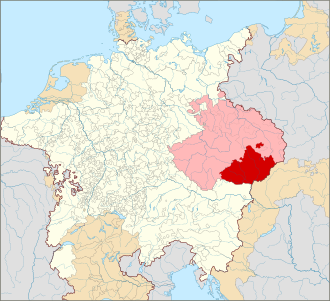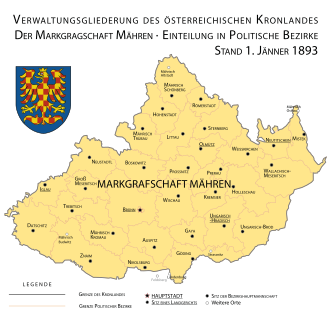Top Qs
Timeline
Chat
Perspective
Margraviate of Moravia
Part of the Bohemian Crown from 1182 to 1918 From Wikipedia, the free encyclopedia
Remove ads
The Margraviate of Moravia (Czech: Markrabství moravské; German: Markgrafschaft Mähren) was one of the Lands of the Bohemian Crown within the Holy Roman Empire and then Austria-Hungary, existing from 1182 to 1918. It was officially administered by a margrave in cooperation with a provincial diet. It was variously a de facto independent state, and also subject to the Duchy, later the Kingdom of Bohemia. It comprised the historical region called Moravia, which lies within the present-day Czech Republic.
This article includes a list of general references, but it lacks sufficient corresponding inline citations. (March 2023) |
Remove ads
Geography
The Margraviate lay east of Bohemia proper, with an area about half that region's size. In the north, the Sudeten Mountains, which extend to the Moravian Gate, formed the border with the Polish Duchy of Silesia, incorporated as a Bohemian crown land upon the 1335 Treaty of Trentschin. In the east and southeast, the western Carpathian Mountains separated it from present-day Slovakia. In the south, the winding Thaya River marked the border with the Duchy of Austria.
Moravians, usually considered a Czech people that speak Moravian dialects, made up the main part of the population. According to a 1910 Cisleithanian census, 27.6% identified themselves as German Moravians.[1] These ethnic Germans would later be expelled after the Second World War. Other ethnic minority groups included Poles, Roma and Slovaks.
Remove ads
History
Summarize
Perspective
After the early medieval Great Moravian realm had been finally defeated by the Árpád princes of Hungary in 907, what is now Slovakia was incorporated as "Upper Hungary" (Felső-Magyarország), while adjacent Moravia passed under the authority of the Duchy of Bohemia. King Otto I of Germany officially granted it to Duke Boleslaus I in turn for his support against the Hungarian forces in the 955 Battle of Lechfeld. Temporarily ruled by King Bolesław I Chrobry of Poland from 999 until 1019, Moravia was re-conquered by Duke Oldřich of Bohemia and ultimately became a land of the Crown of Saint Wenceslas held by the Přemyslid dynasty.[1]

In 1182, the Margraviate was created at the behest of Emperor Frederick Barbarossa by merger of the three Přemyslid appanage principalities of Brno, Olomouc and Znojmo, and given to Conrad II, the son of Prince Conrad of Znojmo. As heir apparent, the future King Ottokar II of Bohemia was appointed Moravian margrave by his father Wenceslaus I in 1247. Along with Bohemia, Moravia was ruled by the House of Luxembourg from the extinction of the Přemyslid dynasty until 1437. Jobst, nephew of Emperor Charles IV inherited the Margraviate in 1375, ruled autonomously and was even elected King of the Romans in 1410. Shaken by the Hussite Wars, the Moravian nobles remained loyal supporters of the Luxembourg emperor Sigismund.[1]
In 1469, Moravia was occupied by the Hungarian king Matthias Corvinus, who had allied with the Catholic nobility against the rule of George of Poděbrady and had himself elected rival king of Bohemia at Olomouc. The rivalry with King Vladislaus II was settled in the 1479 Peace of Olomouc, whereby Matthias renounced the royal title but retained the rule over the Moravian lands.[2]
From 1599 to 1711, Moravia was frequently subjected to raids by the Ottoman Empire and its vassals (especially the Tatars and Transylvania). Overall, hundreds of thousands were enslaved whilst tens of thousands were killed.[3]
With the other lands of the Bohemian Crown, the Margraviate was incorporated into the Habsburg monarchy upon the death of King Louis II in the 1526 Battle of Mohács. Moravia was ruled as a crown land within the Austrian Empire from 1804 and within Cisleithanian Austria from 1867.[4]
During the foundation of Czechoslovakia after World War I, the Margraviate was transformed into "Moravia Land", later "Moravia-Silesia Land" in 1918. This autonomy was eliminated in 1949 by the communist government and has not been re-established since.[1]
Remove ads
Government
Summarize
Perspective

The margrave held ultimate authority in Moravia, throughout the history of the margraviate. This meant that as its margraves became more foreign, so too did governance of the margraviate.
Moravia possessed a legislature, known as the Moravian Diet. The assembly has its origins in 1288, with the Colloquium generale, or curia generalis.[5] This was a meeting of the upper nobility, knights, the Bishop of Olomouc, abbots and ambassadors from royal cities. These meetings gradually evolved into the diet.
The power of this diet waxed and waned throughout history. By the end of the margraviate, the diet was almost powerless. The diet consisted of three estates of the realm: the estate of upper nobility, the estate of the lower nobility, and the estate of prelates and burghers.[6] With the February Patent of 1861, the diet was reformed into a more egalitarian body. It still retained the same structure, but the members changed. It consisted of assembly seats for landowners, city-dwellers, and rural farmers. This was retained until the diet was abolished after the fall of the Dual Monarchy.[6]
Moravian eagle

The coat of arms of Moravia is charged with a crowned silver-red chequered eagle with golden claws and tongue. It first appeared in the seal of Margrave Přemysl (1209–1239), a younger son of King Ottokar I of Bohemia. After 1462, the Moravian eagle was gold-red chequered,[2] but was never accepted by the Moravian assembly.
Remove ads
Administration
Summarize
Perspective
Until 1848
In the mid 14th century Emperor Charles IV, also King of Bohemia and Margrave of Moravia, established administrative divisions called kraje (Kreise in German). These subdivisions were named for their capitals:
After 1848

After the 1848 revolutions, political districts (politický okres, politische Bezirke; formally Bezirkshauptmannschaften) were established, which were organised into two Kreise/kraje – Brünn and Olmütz.[7]
- Brünner Kreis (Brněnský kraj) – 12 districts:
- Brünn
- Trübau
- Boskowitz
- Witschau
- Gaya
- Auspitz
- Iglau
- Datschitz
- Znaym [sic]
- Kromau
- Nikolsburg
- Olmützer Kreis (Olomoucký kraj) – 13 districts:
- Olmütz
- Sternberg
- Schönberg
- Hohenstadt
- Littau
- Neutitschein
- Weißkirchen
- Wistek
- Wallachisch-Meseritsch
- Hradisch
- Kremsier
- Holleschau
- Ungarischbrod [sic]
In Bach's reforms of 1854 the former kraje were restored (albeit with some minor border changes and with Nový Jičín (Neutitschein) replacing Přerov) and the political districts were replaced by 'office districts' (Amtsbezirke), subordinate to the kraje which distributed some of their authority. The Moravian capital Brno/Brünn acted as the seat for Kreis Brünn/Brněnský kraj but as a statutory city was directly subordinate to Moravia.[8]
- Kreis Brünn (Brněnský kraj) – 17 districts:
- Auspitz
- Austerlitz
- Blansko
- Boskowitz
- Brünn (environs)
- Butschowitz
- Eibenschitz
- Gewitsch
- Klobauk
- Kunstadt
- Lundenburg
- Seelowitz
- Steinitz
- Titschnowitz
- Triebau
- Wischau
- Zwittau
- Kreis Olmütz (Olomoucký kraj) – 17 districts:
- Altstadt
- Hof
- Hohenstadt
- Kojetein
- Littau
- Müglitz
- Mährisch-Naustadt
- Olmütz (environs)
- Plumenau
- Prerau
- Proßnitz
- Römerstadt
- Schildberg
- Schönberg
- Sternberg
- Weisenberg
- Olmütz (city)
- Kreis Neutitschein – 13 districts:
- Bystřitz
- Frankstadt
- Freiberg
- Fulnek
- Leipnitz
- Liebau
- Walachisch-Meseritsch
- Mistek
- Neutitschein
- Mährisch-Ostrau
- Rožnau
- Weißkirchen
- Wsetin
- Kreis Hradisch (Hradišťský kraj) – 12 districts:
- Ungarisch-Brod
- Gaya
- Göding
- Holleschau
- Hradisch
- Klobauk
- Kremsier
- Rapajedl
- Ungarisch-Ostra
- Stražnitz
- Wisowitz
- Zdaunek
- Kreis Znaim (Znojemský kraj) – 9 districts:
- Mährisch-Budwitz
- Frain
- Hrottowitz
- Jamnitz
- Joslowitz
- Kromau
- Namiescht
- Nikolsburg
- Znaim
- Kreis Iglau (Jihlavský kraj) – 8 districts:
- Bystřitz
- Datschitz
- Iglau
- Groß-Meseritsch
- Neustadtl
- Saar
- Teltsch
- Trebitsch
In 1860 the Kreise/kraje were dissolved and the districts were subordinated directly to the Statthalterei in Brünn/Brno.[9]
Political districts were re-established in the December Constitution following the Austro-Hungarian Compromise of 1867 and remained in place until Austria-Hungary's dissolution. They were largely retained by the Czechoslovak administration after 1918:
- Boskovice
- Brno
- Dačice
- Hodonín
- Holešov
- Hranice na Moravě
- Hustopeče
- Jihlava
- Kroměříž
- Kyjov
- Litovel
- Mikulov
- Místek
- Moravská Třebová
- Moravské Budějovice
- Moravský Beroun
- Moravský Krumlov
- Nové Město na Moravě
- Nový Jičín
- Olomouc
- Ostrava
- Přerov
- Prostějov
- Rýmařov
- Šternberk
- Šumperk
- Tišnov
- Třebíč
- Uherské Hradiště
- Uherský Brod
- Valašské Meziříčí
- Velké Meziříčí
- Vsetín
- Vyškov
- Zábřeh
- Znojmo
Remove ads
Demographics
Summarize
Perspective
The region experienced rapid population growth when it was part of Austria-Hungary. From 1890 to 1900 alone there was an increase of 7.1%. The population development from 1851 to 1900 was as follows:
Ethnicity

In terms of ethnicity, the population was predominantly divided between Czechs and Germans. The German minority mostly lived on the borders with Lower Austria and Silesia, and in various language islands (around Brünn, Olmütz, Iglau and Zwittau), as well as in some larger cities. The ethnic distribution according to the census was as follows:
Population by district (1910)

Remove ads
Rulers of Moravia
Summarize
Perspective
- Part of Great Moravia (c. 820–907)
Dukes in Moravia (907-1182)
Přemyslid dynasty as Duke of Bohemia (907-999)
Piast dynasty as Duke of Poland (999-1019)
Přemyslid dynasty as Duke in Moravia (1019-1182)
Margraves of Moravia
Přemyslid dynasty
- Conrad II Otto 1182–1191
united with Bohemia 1189–1197
- Vladislaus I Henry 1197–1222, second son of King Vladislaus II of Bohemia and Judith of Thuringia
- Vladislaus II 1223–1227, son of King Ottokar I of Bohemia and Constance of Hungary
- Přemysl 1227–1239, son of King Ottokar I of Bohemia and Constance of Hungary
- Vladislaus III 1239–1247, son of King Wenceslaus I of Bohemia and Kunigunde of Hohenstaufen
- Ottokar II 1247–1278, son of King Wenceslaus I of Bohemia and Kunigunde of Hohenstaufen
directly held by King Rudolph I of Germany 1278–1283
- Wenceslaus II 1283–1305, son of King Ottokar II of Bohemia and Kunigunda of Halych
- Wenceslaus III 1305–1306, son of King Wenceslaus II of Bohemia and Judith of Habsburg
Various dynasties
- Rudolf I of Habsburg 1306–1307, son of King Albert I of Germany and Elizabeth of Carinthia
- Henry of Carinthia 1307–1310, son of Duke Meinhard of Carinthia and Elisabeth of Bavaria
Luxembourgs
- John 1310–1333, son of Emperor Henry VII and Margaret of Brabant
- Charles 1333–1349, son of King John of Bohemia and Elizabeth
- John Henry 1349–1375, enfeoffed by his brother King Charles IV
- Jobst of Moravia 1375–1411, son of John Henry, with his brothers John Sobieslaus (until 1382) and Prokop (until 1405)
- Sigismund 1419–1423, son of Emperor Charles IV and Elizabeth of Pomerania
Various dynasties
- Albert V of Austria 1423–1439, son-in-law of Sigismund
- Ladislaus the Posthumous 1440–1457, son of Albert and grandson of Sigismund
- George of Poděbrady 1458–1468
- Matthias Corvinus 1468–1490, second son of John Hunyadi and Erzsébet Szilágyi
Jagiellons
- Vladislaus II 1490–1516, son of King Casimir IV Jagiellon of Poland and Elisabeth of Habsburg
- Louis II 1516–1526, son of King Vladislaus II
Habsburgs
- Ferdinand I 1527–1564, fourth child of Philip I and Joanna of Castile
- Maximilian II 1564–1576, son of Emperor Ferdinand I and Anne of Bohemia and Hungary
- Rudolf II 1576–1608, son of Emperor Maximilian II
- Matthias II 1608–1617, son of Emperor Maximilian II
Under the united rule of the Bohemian kings from 1611 (see List of rulers of Bohemia).
Remove ads
References
External links
Wikiwand - on
Seamless Wikipedia browsing. On steroids.
Remove ads
























